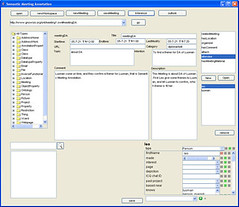Thesis on Semantic Meeting Annotation published
Man Luo's Diploma Thesis on Semantic Meeting Annotation is published. She developed a prototype, based on Gnowsis alpha 0.8, to manage Meetings semantically, identifying problems in PIM and solving them using Jena and Java.
You can download:
The treasures for you Semantic Web hackers:
Nowadays, the personaldesktop contains an enormous amount of information, which we use, process, and search in our daily work. Facing so much information, people pay more attention to Personal Information Management (PIM), which enables people to gather, organize, and synthesize information with flexibility and speed.
A significant use for PIM is in business environments, for instance, categorizing business-partners contact information; arranging the agenda; retrieving business information in internet and so on. Among the business actions meetings are important components, and accordingly the management of meeting is treated as a cornerstone of PIM. It assists people to annotate meeting information, collect related materials, and manage different meeting notes, etc.Using current PIM tools, we still face the problems of filing information and information overload. In order to exceed today's state, this thesis presents a meeting management tool based on the Semantic Desktop environment-- Gnowsis, which is an extension of desktop computers using Semantic Web techniques.
We call this tool Semantic Meeting Annotation. It builds on a Meeting Ontology that defines all the elements and relations in the meeting domain using the Web Ontology Language (OWL). The ontology binds with the annotation application to provide the user a semantic annotation environment, that is, the user can annotate meeting information with all kinds of data, and create links between a meeting and the related data according to the semantic relations defined in the meeting ontology. Other applications (e.g. Microsoft Outlook) based on the Semantic Desktop technology are integrated.
Additionally, the semantic meeting annotation is used to infer new knowledge, based on existing annotation information and rules, by this the user's effort to enter information is reduced. The implementation is using the Jena inference engine and a series of inference rules.
We think that, using semantic meeting annotation will enable the user to annotate a meeting effectively and semantically.
You can download:
- Diploma Thesis: Man Luo, Semantic Meeting Annotation
- The sources of the java project
- Browse the sources online

The treasures for you Semantic Web hackers:
- She cites many of you guys out there, from Dennis Quan to Xiao & Cruz.
- A nice application prototype came out.
- Jena was used to transform one RDF vocabulary to another, like Leigh Dodds did here. Her Java/Jena code on that is here. And she uses these rules.
Nowadays, the personaldesktop contains an enormous amount of information, which we use, process, and search in our daily work. Facing so much information, people pay more attention to Personal Information Management (PIM), which enables people to gather, organize, and synthesize information with flexibility and speed.
A significant use for PIM is in business environments, for instance, categorizing business-partners contact information; arranging the agenda; retrieving business information in internet and so on. Among the business actions meetings are important components, and accordingly the management of meeting is treated as a cornerstone of PIM. It assists people to annotate meeting information, collect related materials, and manage different meeting notes, etc.Using current PIM tools, we still face the problems of filing information and information overload. In order to exceed today's state, this thesis presents a meeting management tool based on the Semantic Desktop environment-- Gnowsis, which is an extension of desktop computers using Semantic Web techniques.
We call this tool Semantic Meeting Annotation. It builds on a Meeting Ontology that defines all the elements and relations in the meeting domain using the Web Ontology Language (OWL). The ontology binds with the annotation application to provide the user a semantic annotation environment, that is, the user can annotate meeting information with all kinds of data, and create links between a meeting and the related data according to the semantic relations defined in the meeting ontology. Other applications (e.g. Microsoft Outlook) based on the Semantic Desktop technology are integrated.
Additionally, the semantic meeting annotation is used to infer new knowledge, based on existing annotation information and rules, by this the user's effort to enter information is reduced. The implementation is using the Jena inference engine and a series of inference rules.
We think that, using semantic meeting annotation will enable the user to annotate a meeting effectively and semantically.
|
leobard - 2. Jun, 13:50
|
|
- add comment - 0 trackbacks






